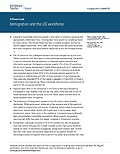A Closer Look: Immigration and the US Workforce
Long-term sustainable economic growth in any nation is linked to a growing and appropriately skilled labor force. Slowing labor force growth is a challenge now faced by many nations, but the United States has been a notable exception among the world's largest economies. Since 1990, the US labor force has grown by almost 30% and immigrants have accounted for about half of this net increase. Immigrants comprise roughly 17% of the US workforce but are more heavily represented in highly skilled areas such as IT, mathematics, engineering, healthcare, and financial services. During the last five years, more than half of all US Nobel laureates were immigrants.
Many low-end service occupations that are not easily scaled by automation also have a high concentration of foreign-born workers. These jobs are projected to grow rapidly in the coming decade; native workers alone may not be able to meet this increase in labor demand. Second-generation immigrants tend to perform much better economically than their parents due to higher levels of education, language proficiency and other factors. In the 40-50 years prime working age group, second-generation immigrants earn on average 24% more than first-generation immigrants. Approximately 45% of the companies in the Fortune 500 were founded by immigrants or their children, making a significant contribution to job creation. This report from Goldman Sachs Research takes a closer look at the foreign-born workforce in the United States, its characteristics, and how it has changed in relation to shifting economic trends in the country.


